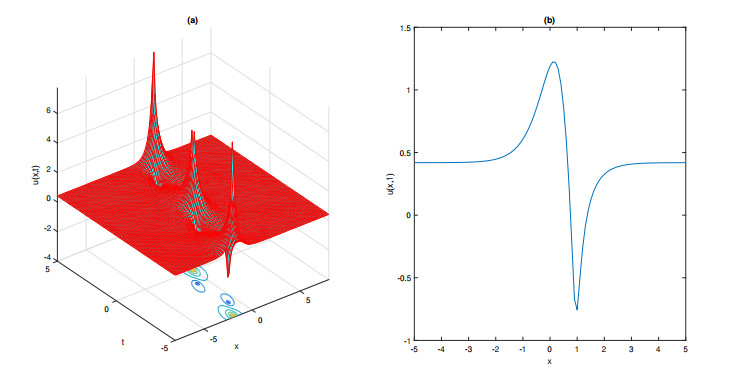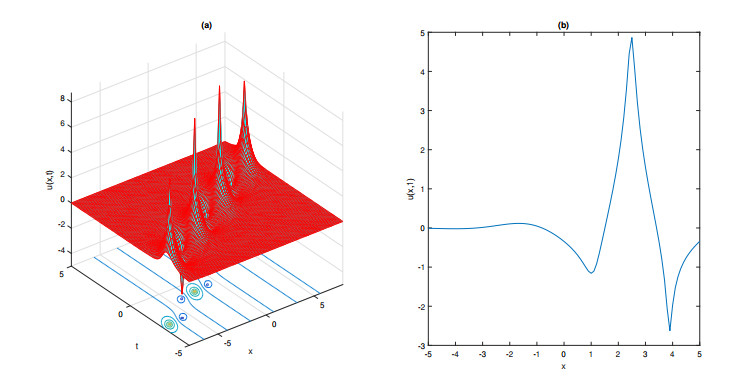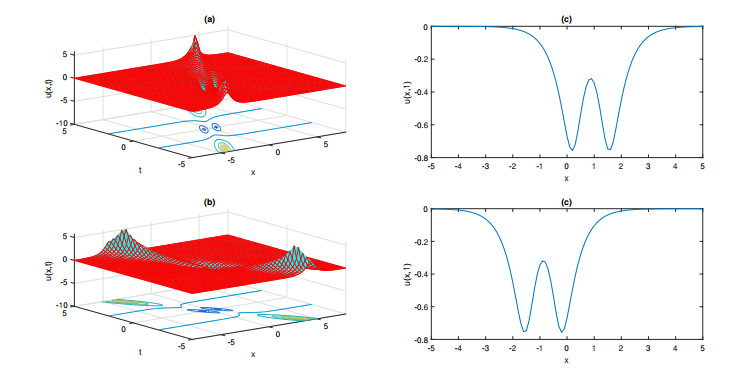Nonlinear equations personate a consequential role in scientific fields such as nonlinear optics, solid state physics and quantum field theory. This article studies the Tzitzéica-Dodd-Bullough-Mikhailov and Tzitzéica-type equations that appear in nonlinear optics. The Painlevé and traveling wave transformations both play a key role in revamping the aforementioned equations into nonlinear ordinary differential equations. Then, the simple ansatz approach is followed to seize complex singular, complex bright solitons and other kink type solutions. The existing literature unveils that this study is a novel contribution in the literature and the proposed approach is forthright and simple to implement for solving nonlinear problems. This approach has no extra condition as compared to many other techniques have. We also verify and interpret graphically the secured solutions through symbolic software Mathematica and MatLab respectively.
1.
Introduction
Finsler geometry extends the classical Riemannian geometry by considering more general metric structures. A very important class of Finsler metrics is known as (α,β)-metrics, which were introduced by M. Matsumoto in 1972. An (α,β)-metric can be expressed as F=αϕ(s), where α is a Riemannian metric and s=βα, β is a 1-form. Randers metric, Kropina metric, exponential metric, Matsumoto metric, and cubic metric are important classes of (α,β)-metric [9].
To study the curvature characteristics is a central problem in Finsler geometry. The Ricci curvature and S-curvature are very important non-Riemannian quantities in the Finslerian manifold [2]. The Ricci curvature in Finsler geometry is a natural extension of the Ricci curvature in Riemannian geometry and is defined as the trace of the Riemann curvature [5]. The S-curvature is a mathematical quantity and measures the rate of change of volume form of a Finsler space along the geodesics. Recent studies in differential geometry, such as those on Ricci solitons and conformal structures, have highlighted the importance of Ricci-type curvatures in understanding the geometric flow and structure of manifolds [6,7,8]. In Finsler geometry, the study of curvature involves understanding the deviation from flatness. The projective Ricci curvature is one aspect of this analysis. The concept of projective Ricci curvature in Finsler geometry is introduced by X. Cheng [1] in 2017. Projective geometry deals with the properties that are invariant under projective transformations. The projective Ricci curvature measures the deviation of the Finsler metric from being projectively flat. Projective Ricci curvature has applications in various areas of mathematics and physics. It plays a crucial role in understanding the geometry of Finsler manifolds and connects to the problems in the calculus of variations, differential equations, and geometric optics.
In 2020, H. Zhu [15] gave an expression of projective Ricci curvature for an (α,β)-metric. Later on, many geometers [4,12,13] have studied the geometric properties of projective Ricci curvature. In this article, we obtain the geometric properties and flatness condition of projective Ricci curvature for the cubic Finsler metric, which is defined as F=αϕ(s) with
i.e., F=(α+β)3α2. Cubic metric is Finsler metric for b2<14 [14].
The following notations will be used to state our main result:
where ";" denotes the covariant derivative with respect to the Levi-Civita connection of the Riemannian metric α.
A 1-form β is said to be a Killing form if rij=0. The 1-form β is said to be a constant Killing form if it is a Killing form and constant length concerning α, equivalently rij=0 and si=0.
In this paper we will use the following lemma:
Lemma 1.1. If α2=0(modβ), that is, aijyiyj contains bi(x)yi as a factor, then the dimension is equal to two and b2 vanishes. In this case, we have δ=di(x)yi satisfying α2=βδ and dibi=2.
We first prove the following result:
Theorem 1.1. For the cubic Finsler metric F=(α+β)3α2 on an n-dimensional (n>2) Finsler manifold M, the S-curvature vanishes if and only if β is a constant Killing form.
Next, we obtain the flatness condition for the projective Ricci curvature as
Theorem 1.2. If the n-dimensional (n>2) Finsler space with cubic metric F=(α+β)3α2 is projective Ricci-flat (PRic=0), then β is parallel with respect to the Riemannian metric α.
In view of the above result, we obtain
Corollary 1.1. If the n-dimensional (n>2) Finsler space with cubic metric F=(α+β)3α2 is projective Ricci flat then, it vanishes the S-curvature. Therefore, the Riemannian metric of α is Ricci flat (Ricα=0).
We also prove the following result:
Theorem 1.3. The n-dimensional (n>2) Finsler space with cubic metric F=(α+β)3α2 is weak PRic-curvature if and only if it is a PRic-flat metric.
2.
Preliminaries
Let F be an n-dimensional Finsler manifold, and let Gj be the geodesic coefficients of F, which are defined as
The geodesic coefficients of an (α,β)-metric are given as [3]
where Giα denotes the geodesic coefficients of the Riemannian metric α and
For any xϵM and yϵTxM∖{0}, the Riemann curvature Ry is defined as
where
The trace of Riemann curvature is called Ricci curvature Ric=Rmm, which is a mathematical object that regulates the rate at which a metric ball's volume in a manifold grows. A Finsler metric F is called an Einstein metric if Ricci curvature satisfies the equation Ric(x,y)=(n−1)γF2, where γ=γ(x) is a scalar function.
In 1997, Z. Shen [11] discussed S-curvature, which measures the average rate of change of (TxM;Fx) in the direction yϵTxM and is defined as
where σF is defined as
and Vol denotes the Euclidean volume, and Bn(1) denotes the unit ball in Rn.
The expression of S-curvature for an (α,β)-metric is given as [10]
where
The projective Ricci curvature is first defined by X. Cheng [1] as
where "|" denotes the horizontal covariant derivative with respect to the Berwald connections of F. A Finsler space F is called weak projective Ricci curvature if
where γ=γ(x) is a scalar function and θ=θi(x)yi is a 1-form. If γ= constant, then F is called constant projective Ricci curvature. If θ=0, then F is called isotropic projective Ricci curvature PRic = (n−1)γF2.
In 2020, H. Zhu [15] gave an expression of the projective Ricci curvature for the (α,β)-metrics as
where
3.
S-curvature of cubic metrics
For Eq (1.1), we obtain the following values:
By using Eqs (2.1) and (3.1), we obtain the spray coefficient Gj for the cubic metric as
In view of Eqs (2.5) and (3.1) and using Mathematica program, we obtain the S-curvature for the cubic Finsler metric as
Now, we are in the position to prove Theorem 1.1.
Proof of Theorem 1.1. First we prove the converse part.
Let us assume that β is a constant Killing form i.e., s0=0 and r00=0; putting this in Eq (3.3) vanishes the S-curvature.
For the if part, let us take S=0; then Eq (3.3) becomes
where
Taking the rational and irrational parts of Eq (3.4), we obtain
From Eqs (3.5) and (3.6), we can say that α2 will divide t0 as well as t1. In view of Lemma 1.1,α2 is coprime with β for n>2. Solving Eqs (3.5) and (3.6), we get, respectively,
and
From the above equations, we obtain
for some scalar function c=c(x) on M.
Putting the above values in Eq (3.4) and simplifying, we get
where (...) denotes the polynomial term in α and β. Here also α2 does not divide β5 and (cβ+s0). Therefore, cβ+s0=0. Differentiating it with respect to yi, we obtain cbi+si=0, which, on contracting by bi, gives c=0, implying s0=0 and r00=0. Which means β is a constant Killing form.
This completes, the proof of Theorem 1.1. □
4.
Ricci curvature of cubic metric
In this section we obtain the projective Ricci curvature for the aforesaid metric.
Proof of Theorem 1.2. For this, we first obtain all the values of Eq (2.8) by using Eq (3.1) and the Mathematica program as
Plugging all the values of the above Eq (4.1) into Eq (2.7) and simplifying by the using Mathematica program, we obtain the projective Ricci curvature for the aforesaid metric as
where
Next, we obtain the flatness condition under which the projective Ricci curvature vanishes.
Let the projective Ricci curvature PRic=0, which implies U(α,β)=0, where
Using Mathematica, we can see that
Therefore
where (....) are polynomial in α and β. As B<14, therefore ((1+6B)α2−αβ−8β2) does not divide (α−2β)3 or (α+β)2 or (α+16β)2. Therefore ((1+6B)α2−αβ−8β2) will divide (r00(α−2β)−6s0α2)2; then ((1+6B)α2−αβ−8β2) will also divide (r00(α−2β)−6s0α2), i.e.,
where c1 is a 1-form and c0 is a scalar. Taking the rational and irrational parts of the above equation, we obtain
and
Solving the above equations, we get c1=−85βc0, and then (4.5) gives
Substituting the above values into Eq (4.4), we obtain
Differentiating the above equation with respect to yi gives (4B−1)c0bi+si=0, which, on contracting by bi, we obtain c0=0. Then from Eqs (4.6) and (4.7), we obtain
In view of (4.8), Eq (4.3) becomes
which can be rewritten as
Since (α−2β) does not divide α2 or β, therefore (α−2β) will divide s0ksk0. Thus
where d1 is a 1-form and d0 is a scalar. Taking the rational and irrational parts of the above equation and solving, we obtain
If d0≠0 then one can conclude by the above equation that α is not positive definite, which is not possible. Therefore, d0=0. This implies that
i.e., β is closed. In view of Eqs (4.8) and (4.10), we obtain bi;k=0, then 1-form β is parallel with respect to α.
This completes the proof of Theorem 1.2. □
Now, we obtain the condition for the weak projective Ricci curvature of a cubic Finsler metric.
Proof of Theorem 1.3. Let F be a cubic Finsler metric with weak projective Ricci curvature. Then from Eq (2.6) we obtain
For the cubic metric, we have B<14, which implies that α4 does not divide (α−2β)3 or ((1+6B)α2−αβ−8β2)4 or 3θ(α+β)3α2. Consequently, it follows that α2 must divide γ(α+β)6. However, such division is only possible if γ=0. Combining this result with Eq (4.11), then we deduce that 3θ(α+β)3 is divided by α2. This is impossible unless θ=0. Then F reduces to a projective Ricci-flat metric.
The converse is obvious. This completes the proof. □
Example 4.1. The Finsler metric 1|y|2(|y|+<a,y>)3 for a=constant is projectively Ricci flat.
5.
Conclusions
Projective Ricci curvature is a concept in differential geometry that generalizes the notion of Ricci curvature. It has various applications in the fields of general relativity, optimal transformation theory, complex geometry, Weyl geometry, Einstein metrics, and many more. In this article, we have proved that if the cubic metric F=(α+β)3α2 is projective Ricci flat (PRic=0), then β is parallel with respect to Riemannian metric α, and then from Eq (2.3), the S-curvature vanishes. Therefore, from Eq (2.5), we obtain that the Riemannian metric α is also Ricci-flat, which is Corollary 1.1.
Author contributions
M. K. Gupta and S. Sharma wrote the framework and the original draft of this manuscript. Y. Li and Y. Xie reviewed and validated the manuscript. All authors have read and agreed to the final version of the manuscript.
Use of AI tools declaration
The authors declare they have not used Artificial Intelligence (AI) tools in the creation of this article.
Conflict of interest
The authors declare no conflict of interest.

















 DownLoad:
DownLoad: